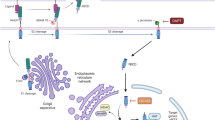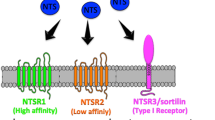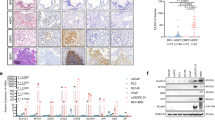Abstract
Carcinoids are slow-growing neuroendocrine tumors (NETs) that are characterized by hormone overproduction; surgery is currently the only option for treatment. Activation of the Notch pathway has previously been shown to have a role in tumor suppression in NETs. The marine-derived thiodepsipeptide thiocoraline was investigated in vitro in two carcinoid cell lines (BON and H727). Carcinoid cells treated with nanomolar concentrations of thiocoraline resulted in a decrease in cell proliferation and an alteration of malignant phenotype evidenced by decrease of NET markers, achaete-scute complex like-1, chromogranin A and neurospecific enolase. Western blotting analysis demonstrated the activation of Notch1 on the protein level in BON cells. Additionally, thiocoraline activated downstream Notch targets HES1, HES5 and HEY2. Thiocoraline effectively suppressed carcinoid cell growth by promoting cell cycle arrest in BON and H727 cells. An in vivo study demonstrated that thiocoraline, formulated with polymeric micelles, slowed carcinoid tumor progression. Thus the therapeutic potential of thiocoraline, which induced activation of the Notch pathway, in carcinoid tumors was demonstrated.
This is a preview of subscription content, access via your institution
Access options
Subscribe to this journal
Receive 12 print issues and online access
$259.00 per year
only $21.58 per issue
Buy this article
- Purchase on Springer Link
- Instant access to full article PDF
Prices may be subject to local taxes which are calculated during checkout





Similar content being viewed by others
References
Pinchot SN, Holen K, Sippel RS, Chen H . Carcinoid tumors. Oncologist 2008; 13: 1255–1269.
Sippel RS, Chen H . Carcinoid tumors. Surg Oncol Clin N Am 2006; 15: 463–478.
Kulke MH, Mayer RJ . Carcinoid tumors. N Engl J Med 1999; 340: 858–868.
Schnirer II, Yao JC, Ajani JA . Carcoinoid—a comprehensive review. Acta Oncol 2003; 42: 672–692.
Taal BG, Visser. O . Epidemiology of neuroendocrine tumours. Neuroendocrinology 2004; 80 (Suppl 1): 3–7.
Modlin IM, Lye KD, Kidd M . A 5-decade analysis of 13,715 carcinoid tumors. Cancer 2003; 97: 934–959.
Kunnimalaiyaan M, Chen H . Tumor suppressor role of Notch-1 signaling in neuroendocrine tumors. Oncologist 2007; 12: 535–542.
Allenspach EJ, Maillard I, Aster JC, Pear WS . Notch signaling in cancer. Cancer Biol Ther 2002; 1: 466–476.
Artavanis-Tsakonas S, Rand MD, Lake RJ . Notch signaling: Cell fate control and signal integration in development. Science 1999; 284: 770–776.
Bray SJ . Notch signalling: a simple pathway becomes complex. Nat Rev Mol Cell Bio 2006; 7: 678–689.
Pérez Baz J, Cañedo LM, Fernández-Puentes JL, Silva Elipe MV . Thiocoraline, a novel depsipeptide with antitumor activity produced by a marine Micromonospora. II. Physico-chemical properties and structure elucidation. J Antibiot 1997; 50: 738–741.
Romero F, Espliego F, Pérez Baz J, García de Quesada T, Grávalos D, De la Calle F et al. Thiocoraline, a new depsipeptide with antitumor activity produced by a marine Micromonospora. I. Taxonomy, fermentation, isolation, and biological activities. J Antibiot 1997; 50: 734–737.
Erba E, Bergamashi D, Ronzoni S, Faretta M, Taverna S, Bonfanti M et al. Mode of action of thiocoraline, a natural marine compound with anti-tumour activity. Brit J Cancer 1999; 80: 971–980.
Negri A, Marco E, García-Hernández V, Domingo A, Llamas-Saiz AL, Porto-Sandá S et al. Antitumor activity, X-ray crystal structure, and DNA binding properties of thiocoraline A, a natural bisintercalating thiodepsipeptide. J Med Chem 2007; 50: 3322–3333.
Wyche TP, Hou Y, Braun D, Cohen HC, Xiong MP, Bugni TS . First natural analogs of the cytotoxic thiodepsipeptide thiocoraline A from a marine Verrucosispora sp. J Org Chem 2011; 76: 6542–6547.
Tesfazghi S, Eide J, Dammalapati A, Korlesky C, Wyche TP, Bugni TS et al. Thiocoraline alters neuroendocrine phenotype and activates the Notch pathway in MTC-TT cell line. Cancer Med 2013; 2: 734–743.
Parkekh D, Ishizuka J, Townsend CM Jr, Haber B, Beauchamp RD, Karp G et al. Characterization of a human pancreatic carcinoid in vitro: morphology, amine and peptide storage, and secretion. Pancreas 1994; 9: 83–90.
Zarebczan B, Pinchot SN, Kunnimalaiyaan M, Chen H . Hesperetin, a potential therapy for carcinoid cancer. Am J Surg 2011; 201: 329–332.
Kunnimalaiyaan M, Yan S, Wong F, Zhang Y, Chen H . Hairy enhancer of split-1 (HES-1), a Notch1 effector, inhibits the growth of carcinoid tumor cells. Surgery 2005; 138: 1137–1142.
Valentino JD, Li J, Zaytseva YY, Mustain WC, Elliot VA, Kim JT et al. Cotargeting the PI3K and RAS pathways for the treatment of neuroendocrine tumors. Clin Cancer Res 2014; 20: 1212–1222.
Van Gompel JJ, Kunnimalaiyaan M, Holen K, Chen H . ZM336372, a Raf-1 activator, suppresses growth and neuroendocrine hormone levels in carcinoid tumor cells. Mol Cancer Ther 2005; 4: 910–917.
Kunnimalaiyaan M, Vaccaro AM, Ndiaye MA, Chen H . Overexpression of the NOTCH1 intracellular domain inhibits cell proliferation and alters the neuroendocrine phenotype of medullary thyroid cancer cells. J Biol Chem 2006; 281: 39819–39830.
Jaskula-Sztul R, Pisarnturakit P, Landowski M, Chen H, Kunnimalaiyaan M . Expression of the active Notch1 decreases MTC tumor growth in vivo. J Surg Res 2011; 171: 23–27.
Vaccaro A, Chen H, Kunnimalaiyaan M . In-vivo activation of Raf-1 inhibits tumor growth and development in a xenograft model of human medullary thyroid cancer. Anticancer Drugs 2006; 17: 849–853.
Shin HC, Alani AW, Cho H, Bae Y, Kolesar JM, Kwon GS . A 3-in-1 polymeric micelle nanocontainer for poorly water-soluble drugs. Mol Pharm 2011; 8: 1257–1265.
Chen H, Udelsman R, Zeiger M, Ball D . Human achaete-scute homolog-1 is highly expressed in a subset of neuroendocrine tumors. Oncol Rep 1997; 4: 775–778.
Oberg K, Janson ET, Eriksson B . Tumor markers in neuroendocrine tumours. Ital J Gastroenterol Hepatol 1999; 31 (Suppl 1): S160–S162.
Mohammed TA, Holen KD, Jaskula-Sztul R, Mulkerin D, Lubner SJ, Schelman WR et al. A pilot Phase II study of valproic acid for treatment of low-grade neuroendocrine carcinoma. Oncologist 2011; 16: 835–843.
Faircloth G, Jimeno J, D’lncalci M . Biological activity of thiocoraline, a novel marine depsipeptide. Eur J Cancer 1997; 33: S175.
Boger DL, Ichikawa S . Total syntheses of thiocoraline and BE-22179: Establishment of relative and absolute stereochemistry. J Am Chem Soc 2000; 122: 2956–2957.
Boger DL, Ichikawa S, Tse WC, Hedrick MP, Jin Q . Total syntheses of thiocoraline and BE-22179 and assessment of their DNA binding and biological properties. J Am Chem Soc 2001; 123: 561–568.
Tulla-Puche J, Góngora-Benítez M, Bayó-Puxan N, Francesch AM, Cuevas C, Albericio F . Enzyme-labile protecting groups for the synthesis of natural products: solid-phase synthesis of thiocoraline. Angew Chem Int Ed Engl 2013; 52: 5726–5730.
Lombó F, Velasco A, Castro A, de la Calle F, Braña AF, Sánchez-Puelles JM et al. Deciphering the biosynthesis pathway of the antitumor thiocoraline from a marine actinomycete and its expression in two Streptomyces species. Chembiochem 2006; 7: 366–376.
Sheoran A, King A, Velasco A, Pero JM, Garneau-Tsodikova S . Characterization of TioF, a tryptophan 2,3-dioxygenase involved in 3-hydroxyquinaldic acid formation during thiocoraline biosynthesis. Mol Biosyst 2008; 4: 622–628.
Robbel L, Hoyer KM, Marahiel MA . TioS T-TE – a prototypical thioesterase responsible for cyclodimerization of the quinoline- and quinoxaline-type class of chromodepsipeptides. FEBS J 2009; 276: 1641–1653.
Biswas T, Zolova OE, Lombó F, de la Calle F, Salas JA, Tsodikov OV et al. A new scaffold of an old protein fold ensures binding to the bisintercalator thiocoraline. J Mol Biol 2010; 397: 495–507.
Mady AS, Zolova OE, Lombó F, de la Calle F, Salas JA, Tsodikov OV et al. Characterization of TioQ, a type II thioesterase from the thiocoraline biosynthetic cluster. Mol Biosyst 2011; 7: 1999–2011.
Lynge ME, Laursen MB, Hosta-Rigau L, Jensen BE, Ogaki R, Smith AA et al. Liposomes as drug deposits in multilayered polymer films. ACS Appl Mater Interfaces 2013; 5: 2967–2975.
Van der Westen R, Hosta-Rigau L, Sutherland DS, Goldie KN, Albericio F, Postma A et al. Myoblast cell interaction with polydopamine coated liposomes. Biointerphases 2012; 7: 1–9.
Acknowledgements
We thank Sarah Tesfazghi and Jacob Eide for technical help in the laboratory. This work was supported by funding from the University of Wisconsin-Madison School of Pharmacy and by grants NIH R01 CA121115 and American Cancer Society, MEN2 Thyroid Cancer Professorship (120319-RPM-11-080-01-TBG) and American Cancer Society, Research Scholar Award (RSGM TBE-121413) to Dr Herbert Chen.
Author Contributions
R Jaskula-Sztul designed the experiments. H Cho designed the thiocoraline formulation. T Wyche, A Dammalapati, H Cho, A Harrison and R Jaskula-Sztul performed the experiments. T Wyche wrote the manuscript with contributions from R Jaskula-Sztul and reviewed by T Bugni, G Kwon and H Chen.
Author information
Authors and Affiliations
Corresponding author
Ethics declarations
Competing interests
The authors declare no conflict of interest.
Rights and permissions
About this article
Cite this article
Wyche, T., Dammalapati, A., Cho, H. et al. Thiocoraline activates the Notch pathway in carcinoids and reduces tumor progression in vivo. Cancer Gene Ther 21, 518–525 (2014). https://doi.org/10.1038/cgt.2014.57
Received:
Revised:
Accepted:
Published:
Issue Date:
DOI: https://doi.org/10.1038/cgt.2014.57
This article is cited by
-
Molecular Pathology of Well-Differentiated Gastro-entero-pancreatic Neuroendocrine Tumors
Endocrine Pathology (2021)
-
Thiocoraline mediates drug resistance in MCF-7 cells via PI3K/Akt/BCRP signaling pathway
Cytotechnology (2019)
-
Recent progress on the development of antibiotics from the genus Micromonospora
Biotechnology and Bioprocess Engineering (2016)
-
Chrysin suppresses achaete-scute complex-like 1 and alters the neuroendocrine phenotype of carcinoids
Cancer Gene Therapy (2015)



